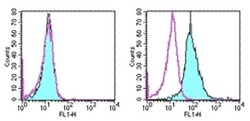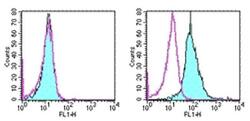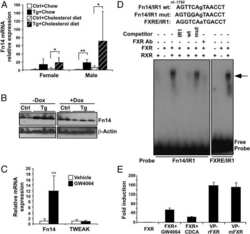Antibody data
- Antibody Data
- Antigen structure
- References [15]
- Comments [0]
- Validations
- Flow cytometry [2]
- Other assay [1]
Submit
Validation data
Reference
Comment
Report error
- Product number
- 14-9018-80 - Provider product page

- Provider
- Invitrogen Antibodies
- Product name
- CD266 (TWEAK Receptor) Monoclonal Antibody (ITEM-4), eBioscience™
- Antibody type
- Monoclonal
- Antigen
- Other
- Description
- Description: The ITEM-4 antibody reacts with human TWEAK Receptor/Fn14 (fibroblast growth factor-inducible 14 kDa protein). Fn14 is distantly related to the TNFR family, containing one cysteine-rich domain in the extracellular region and a TNFR-associated factor binding domain but does not contain a death domain (DD) cytoplasmic region. Fn14 plays a role in TWEAK-induced endothelial cell migration, proliferation, and angiogenesis. TWEAK-induced cell death via Fn14 includes both apoptosis and necrosis and can be blocked by an anti-TWEAK antibody, CARL-1. Fn14 is expressed on HUVEC and in some cancer tissues but not on freshly isolated PBMCs. Fn14 mRNA expression has been identified during liver regeneration. It has been reported that ITEM-4 cross-reacts with mouse Fn14. In the mouse, Fn14 is reported to be constitutively expressed by Colon 26 cell line. The ITEM-4 antibody has been show to have blocking function. Applications Reported: The ITEM-4 antibody has been reported for use in flow cytometric analysis, immunoblotting (WB), and immunohistochemical staining of frozen tissue sections. Applications Tested: The ITEM-4 antibody has been tested by flow cytometric analysis on human and mouse Fn14 transfected cells. This can be used at less than or equal to 1 µg per test. A test is defined as the amount (µg) of antibody that will stain a cell sample in a final volume of 100 µL. Cell number should be determined empirically but can range from 10^5 to 10^8 cells/test. It is recommended that the antibody be carefully titrated for optimal performance in the assay of interest. Purity: Greater than 90%, as determined by SDS-PAGE. Aggregation: Less than 10%, as determined by HPLC. Filtration: 0.2 µm post-manufacturing filtered.
- Reactivity
- Human, Mouse
- Host
- Mouse
- Isotype
- IgG
- Antibody clone number
- ITEM-4
- Vial size
- 25 µg
- Concentration
- 0.5 mg/mL
- Storage
- 4°C
Submitted references Minimizing the non-specific binding of nanoparticles to the brain enables active targeting of Fn14-positive glioblastoma cells.
Chronic activation of FXR in transgenic mice caused perinatal toxicity and sensitized mice to cholesterol toxicity.
Regulation of fibroblast growth factor-inducible 14 (Fn14) expression levels via ligand-independent lysosomal degradation.
HMGB1 expression and secretion are increased via TWEAK-Fn14 interaction in atherosclerotic plaques and cultured monocytes.
Therapeutic potential of the TWEAK/Fn14 pathway in intractable gastrointestinal cancer.
Soluble and transmembrane TNF-like weak inducer of apoptosis differentially activate the classical and noncanonical NF-kappa B pathway.
Tweak induces proliferation in renal tubular epithelium: a role in uninephrectomy induced renal hyperplasia.
The CD163-expressing macrophages recognize and internalize TWEAK: potential consequences in atherosclerosis.
TWEAK is expressed at the cell surface of monocytes during multiple sclerosis.
The cytokine TWEAK modulates renal tubulointerstitial inflammation.
TWEAK induces liver progenitor cell proliferation.
Tumor necrosis factor-like weak inducer of apoptosis-induced neurodegeneration.
Fibroblast growth factor-inducible 14 mediates multiple pathways of TWEAK-induced cell death.
Multiple pathways of TWEAK-induced cell death.
Pro-inflammatory effect of TWEAK/Fn14 interaction on human umbilical vein endothelial cells.
Schneider CS, Perez JG, Cheng E, Zhang C, Mastorakos P, Hanes J, Winkles JA, Woodworth GF, Kim AJ
Biomaterials 2015 Feb;42:42-51
Biomaterials 2015 Feb;42:42-51
Chronic activation of FXR in transgenic mice caused perinatal toxicity and sensitized mice to cholesterol toxicity.
Cheng Q, Inaba Y, Lu P, Xu M, He J, Zhao Y, Guo GL, Kuruba R, de la Vega R, Evans RW, Li S, Xie W
Molecular endocrinology (Baltimore, Md.) 2015 Apr;29(4):571-82
Molecular endocrinology (Baltimore, Md.) 2015 Apr;29(4):571-82
Regulation of fibroblast growth factor-inducible 14 (Fn14) expression levels via ligand-independent lysosomal degradation.
Gurunathan S, Winkles JA, Ghosh S, Hayden MS
The Journal of biological chemistry 2014 May 9;289(19):12976-88
The Journal of biological chemistry 2014 May 9;289(19):12976-88
HMGB1 expression and secretion are increased via TWEAK-Fn14 interaction in atherosclerotic plaques and cultured monocytes.
Moreno JA, Sastre C, Madrigal-Matute J, Muñoz-García B, Ortega L, Burkly LC, Egido J, Martín-Ventura JL, Blanco-Colio LM
Arteriosclerosis, thrombosis, and vascular biology 2013 Mar;33(3):612-20
Arteriosclerosis, thrombosis, and vascular biology 2013 Mar;33(3):612-20
Therapeutic potential of the TWEAK/Fn14 pathway in intractable gastrointestinal cancer.
Yoriki R, Akashi S, Sho M, Nomi T, Yamato I, Hotta K, Takayama T, Matsumoto S, Wakatsuki K, Migita K, Yagita H, Nakajima Y
Experimental and therapeutic medicine 2011 Jan;2(1):103-108
Experimental and therapeutic medicine 2011 Jan;2(1):103-108
Soluble and transmembrane TNF-like weak inducer of apoptosis differentially activate the classical and noncanonical NF-kappa B pathway.
Roos C, Wicovsky A, Müller N, Salzmann S, Rosenthal T, Kalthoff H, Trauzold A, Seher A, Henkler F, Kneitz C, Wajant H
Journal of immunology (Baltimore, Md. : 1950) 2010 Aug 1;185(3):1593-605
Journal of immunology (Baltimore, Md. : 1950) 2010 Aug 1;185(3):1593-605
Tweak induces proliferation in renal tubular epithelium: a role in uninephrectomy induced renal hyperplasia.
Sanz AB, Sanchez-Niño MD, Izquierdo MC, Jakubowski A, Justo P, Blanco-Colio LM, Ruiz-Ortega M, Egido J, Ortiz A
Journal of cellular and molecular medicine 2009 Sep;13(9B):3329-42
Journal of cellular and molecular medicine 2009 Sep;13(9B):3329-42
The CD163-expressing macrophages recognize and internalize TWEAK: potential consequences in atherosclerosis.
Moreno JA, Muñoz-García B, Martín-Ventura JL, Madrigal-Matute J, Orbe J, Páramo JA, Ortega L, Egido J, Blanco-Colio LM
Atherosclerosis 2009 Nov;207(1):103-10
Atherosclerosis 2009 Nov;207(1):103-10
TWEAK is expressed at the cell surface of monocytes during multiple sclerosis.
Desplat-Jégo S, Feuillet L, Creidy R, Malikova I, Rance R, Khrestchatisky M, Hahm K, Burkly LC, Pelletier J, Boucraut J
Journal of leukocyte biology 2009 Jan;85(1):132-5
Journal of leukocyte biology 2009 Jan;85(1):132-5
The cytokine TWEAK modulates renal tubulointerstitial inflammation.
Sanz AB, Justo P, Sanchez-Niño MD, Blanco-Colio LM, Winkles JA, Kreztler M, Jakubowski A, Blanco J, Egido J, Ruiz-Ortega M, Ortiz A
Journal of the American Society of Nephrology : JASN 2008 Apr;19(4):695-703
Journal of the American Society of Nephrology : JASN 2008 Apr;19(4):695-703
TWEAK induces liver progenitor cell proliferation.
Jakubowski A, Ambrose C, Parr M, Lincecum JM, Wang MZ, Zheng TS, Browning B, Michaelson JS, Baetscher M, Wang B, Bissell DM, Burkly LC
The Journal of clinical investigation 2005 Sep;115(9):2330-40
The Journal of clinical investigation 2005 Sep;115(9):2330-40
Tumor necrosis factor-like weak inducer of apoptosis-induced neurodegeneration.
Potrovita I, Zhang W, Burkly L, Hahm K, Lincecum J, Wang MZ, Maurer MH, Rossner M, Schneider A, Schwaninger M
The Journal of neuroscience : the official journal of the Society for Neuroscience 2004 Sep 22;24(38):8237-44
The Journal of neuroscience : the official journal of the Society for Neuroscience 2004 Sep 22;24(38):8237-44
Fibroblast growth factor-inducible 14 mediates multiple pathways of TWEAK-induced cell death.
Nakayama M, Ishidoh K, Kojima Y, Harada N, Kominami E, Okumura K, Yagita H
Journal of immunology (Baltimore, Md. : 1950) 2003 Jan 1;170(1):341-8
Journal of immunology (Baltimore, Md. : 1950) 2003 Jan 1;170(1):341-8
Multiple pathways of TWEAK-induced cell death.
Nakayama M, Ishidoh K, Kayagaki N, Kojima Y, Yamaguchi N, Nakano H, Kominami E, Okumura K, Yagita H
Journal of immunology (Baltimore, Md. : 1950) 2002 Jan 15;168(2):734-43
Journal of immunology (Baltimore, Md. : 1950) 2002 Jan 15;168(2):734-43
Pro-inflammatory effect of TWEAK/Fn14 interaction on human umbilical vein endothelial cells.
Harada N, Nakayama M, Nakano H, Fukuchi Y, Yagita H, Okumura K
Biochemical and biophysical research communications 2002 Dec 6;299(3):488-93
Biochemical and biophysical research communications 2002 Dec 6;299(3):488-93
No comments: Submit comment
Supportive validation
- Submitted by
- Invitrogen Antibodies (provider)
- Main image

- Experimental details
- Staining of non-transfected (left) and human Fn14 transfected (right) L5178Y cells with 0.5 µg of Mouse IgG2a K Isotype Control Purified (Product # 14-4732-82) (open histogram) or 0.5 µg Anti-Human/Mouse CD266 (TWEAK Receptor) Purified (filled histogram) followed byAnti-Mouse IgG FITC (Product # 11-4011-85).Total viable cells were analyzed.
- Submitted by
- Invitrogen Antibodies (provider)
- Main image

- Experimental details
- Staining of non-transfected (left) and human Fn14 transfected (right) L5178Y cells with 0.5 µg of Mouse IgG2a K Isotype Control Purified (Product # 14-4732-82) (open histogram) or 0.5 µg Anti-Human/Mouse CD266 (TWEAK Receptor) Purified (filled histogram) followed byAnti-Mouse IgG FITC (Product # 11-4011-85).Total viable cells were analyzed.
Supportive validation
- Submitted by
- Invitrogen Antibodies (provider)
- Main image

- Experimental details
- NULL
 Explore
Explore Validate
Validate Learn
Learn Western blot
Western blot Flow cytometry
Flow cytometry